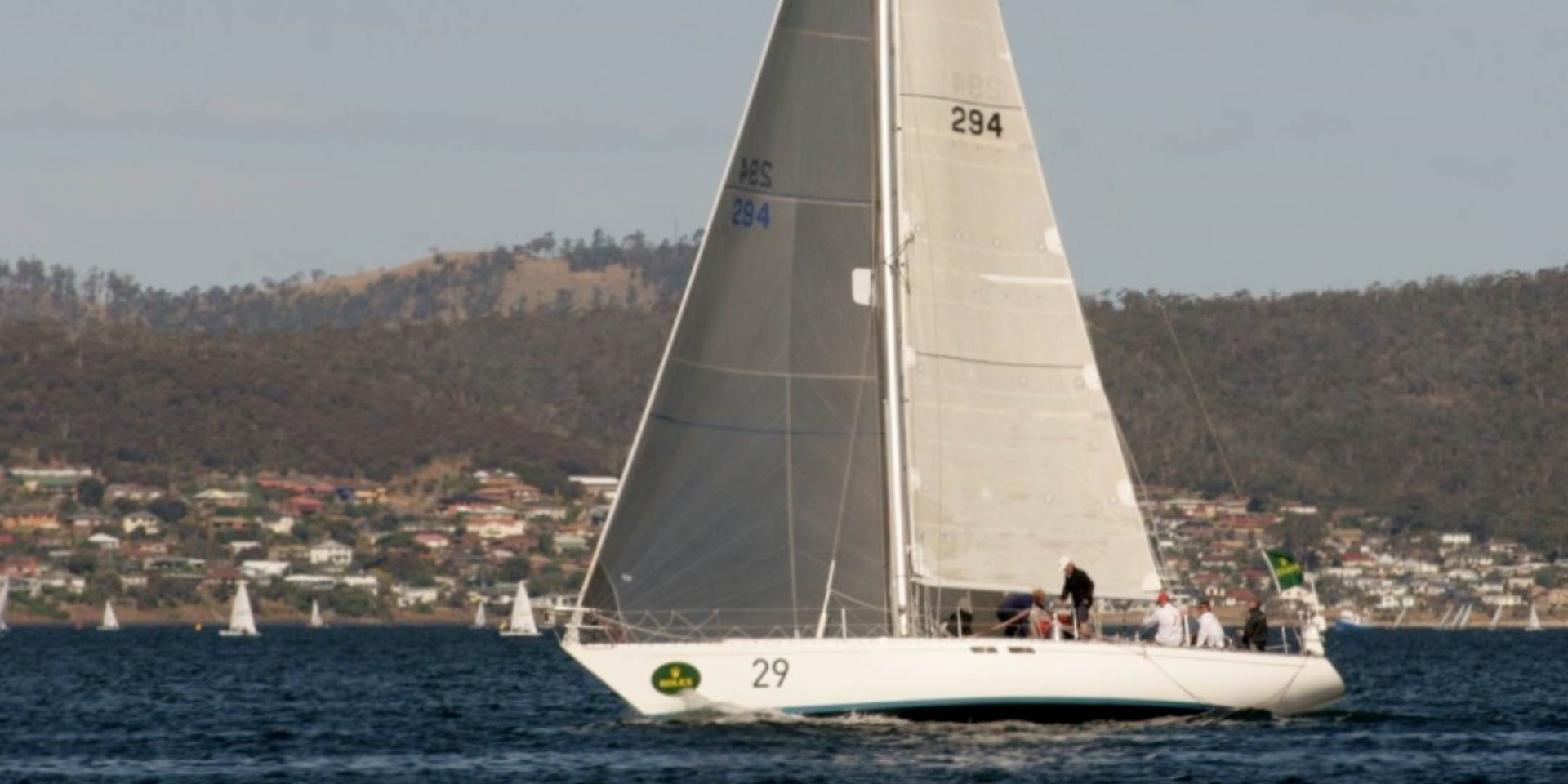
Love & War has won the Sydney to Hobart yacht race three times in 1974, 1978 and 2006, and is only the second yacht to have recorded three wins in this event. Freya won in 1963, 64 and 65.
Love and War. Courtesy Rolex/Cruising Yacht Club of Australia
Love & War was built for Queensland businessman Peter Kurts by shipwright Cec Quilkey at Taren Point NSW and launched late in 1973. It was one of the last racing yachts to be built in cold moulded timber construction. Quilkey had become one of the leading craftsmen for timber yachts and had pioneered cold moulded construction in the mid-1960s starting with Mercedes III, Ragamuffin and Koomooloo, yachts that in their time were to international, state-of-the-art construction.
Love & War was designed early in 1973 by the New York firm Sparkman & Stephens to the International Ocean Racing (IOR) yacht rating rule, the IORC MK III and they were the most successful designers to this complex rule at this time. Their designs were always amongst the leading yachts at the unofficial world championship of ocean racing, the Admiral’s Cup event held every two years in the UK. Love & War was a refinement of the champion boats from the August 1973 series, Germany’s Saudade and the UK yacht Prospect of Whitby. Seacraft magazine carried the following report:
- “Queensland Skipper Peter Kurts has a new Sparkman Stephens 47, almost identical to the successful German Admiral’s Cup SAUDADE and the British PROSPECT OF WHITBY. She is rigged similarly to RAGAMUFFIN’s latest rig. Her mast is a lofty 60 ft (20m) and carries a small main.
- Graham Newland, who is setting up the boat for her owner says she is of medium displacement and like YANKEE GIRL and CHARISMA in rig, preserving all their great windward qualities while incorporating some new ideas on getting down wind faster and leading with less underwater drag.
- Deck layout is the fashionable flush deck with a slight blister aft of the mast. She is cold moulded with four skins and beautifully fashioned as only Cec Quilkey can. Her inside layout is racing clean- no fuss. Sails are by Bouzaid and North with Hughie Treharne making the spinnakers.
- She is named LOVE & WAR.”
Love & War was cold moulded by Quilkey in four layers of Oregon, and was one of the last racing yachts to be built in this manner in Australia. Love & War had a slow start to its career, taking part in the 1973 Sydney to Hobart race but not gaining a place. It became one of the premier yachts for 1974 when it took out the Cruising Yacht Club’s Blue Water Ocean Racing point score along with winning on handicap the 1974 Sydney to Hobart yacht race, the first of three wins in this prestigious event. 1974 was a light weather event, they finished eighth across the line and skipper Kurts praised the navigation skills of Magnus Halvorsen as one of the reasons for their victory.
It then raced in the delayed selection trials for the 1975 Admiral’s Cup team. A series of races were held off the NSW coast in March, dominated by light and variable winds, with ten boats competing for the three places. Love & War came out the top scoring boat, and together with the aluminium Bumblebee III and balsa/timber plank sandwiched hull Mercedes IV made up the Australian team for the series in the UK in August.
This event was a hugely disappointing series for the Australian team, finishing ninth overall, whereas they had never finished worse than third in previous series since 1965. Love & War was sailed well, but the small advances in design and optimisations carried by the very latest 19747/5 designs sailing for other teams were enough to give them consistently better results, and Australia learnt how important it was to sail with the most up to date, highly optimised designs.
Love & War. Courtesy Rolex/Cruising Yacht Club of Australia
Kurts continued to sail Love & War in Australia, and decided to mount another serious challenge for handicap honours in the Sydney to Hobart race for 1978. He optimised the rig and trim further, bought new sails, and although the changes increased the rating, it was also eligible for an age allowance concession, which then took back some of the increased rating. Once again it was good tactical sailing that kept Love & War toward the head of the fleet, and along with seven other boats, they broke away from the rest of fleet off Gabo Island and kept light winds through to the finish, while the remainder were left for up to 15 hours with virtually no wind. Love & War finished 6th overall, and held its time on rivals Margaret Rintouil II and Constellation to take handicap honours for a second time.
Love & War continued to be sailed and raced occasionally, while owner Kurts remained active and competitive in ocean racing with newer designs Drake’s Prayer, Madeleines Daughter and Once More Dear Friends.
Love & War , still owned by the Kurts family, came back to win the 2006 Hobart under the IRC rule, with a crew led by navigator Lindsay May. He had felt the yacht sailed above its IRC rating in headwinds, and knew that given the right conditions they were a good chance for a high placing. In 2006 the fleet sailed most the race until Storm Bay in just those conditions, moderate headwinds with a lumpy sea, which suited Love & War and its experienced crew. For a third time Love & War had taken handicap honours.
Love & War continues to be sailed by the Kurts family and is often seen racing on Sydney Harbour.
